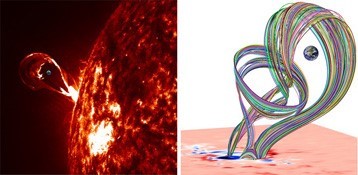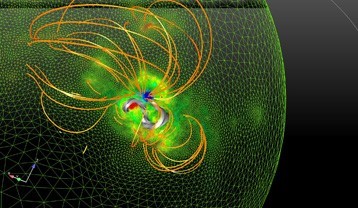Understanding and Forecasting Solar Eruptions
Researchers of the Centre de physique théorique (CNRS/École polytechnique) and of the Laboratoire Astrophysique, interprétation-modélisation (CNRS/CEA/Université Paris Diderot) have identified a key phenomenon in the triggering of solar eruptions. With the help of satellites and of models, the scientists have been able to follow the evolution of the solar magnetic field in a zone of eruptive behavior. Their calculations evidence the formation of a magnetic cord (1) which emerges from the inside of the sun and which is associated with the appearance of a sun spot. They show that this structure plays an important role in the triggering of an eruption. By characterizing the transition towards an eruption, their work opens the door to the forecasting of the solar storms which affect Earth.

Tahar Amari/Centre de Physique Théorique
Left, a typical solar eruption; right: a modelisation of the magnetic cord during the eruption
Solar eruptions are events which occur in the atmosphere of the Sun. They are characterized by emissions of light and of particles as well as, for those on a very large scale, by the ejection of a plasma bubble (2). Understanding the origin of these phenomena is interesting at several levels. First, these eruptions represent a well-observed example, close to us, of physical phenomena occurring everywhere in the Universe. But it is especially their impact on the terrestrial environment which turns the study and forecasts of these eruptions into an important issue. Indeed, they are generating various perturbances which among others affect solar generators on the ground, satellites, as well as GPS and communication systems.
The solar atmosphere is structured into many layers, one of which is the photosphere, which is tantamount to the solar surface, and the corona, the most external zone where eruptions occur. There exists a magnetic field at the level of these layers and it plays an all important role in solar eruptions. Up until now, observations had nevertheless not made it possible to understand exactly the mechanism and the structures that were implied, notably because of the difficulty to measure the magnetic field at any point of the very hot and dense corona.
An eruption which occurred during the night of December 12 to 13, 2006, allowed for an important scientific advance. The concerned area of the Sun was being observed by the Japanese satellite Hinode at the time of the eruption and during the preceding days. Data about the magnetic field of the photosphere, which is colder and denser than the corona, could be collected by the satellite and have allowed scientists to calculate the evolution of the magnetic environment in the corona during this lapse of time.
Starting from calculations made at IDRIS (Centre National de la Recherche Scientifique - CNRS), the scientists showed that a characteristic structure, in the shape of a magnetic cord, appears progressively during the days preceding the eruption. It is completely formed on the day before the phenomenon. This observation agrees very well with the observations made at the level of the photosphere and of the corona: the formation of magnetic cords is consistent with the evolution of sun spots in the region of the eruption and with the appearance of other structures (3). The scientists calculations also show that the energy of the magnetic cord increases as it emerges from inside the Sun.

Tahar Amari/Centre de Physique Théorique
Model of the magnetic field in the region where a major solar eruption occurred on December 13, 2006.
This model was obtained with the help of data of the magnetic field measured on the surface of the Sun and of an adptative high resolution calculation code. It evidences the presence of a magnetic cord (in grey) a few hours before the eruption, held up in equilibrium by magnetic arcades (in orange).
Thanks to a second series of digital simulations, the researchers then followed the evolution of the magnetic field in the corona once the cord was present. Their results show that this structure is indeed at the origin of the eruption and that it is even necessary for its occurrence: the transition towards the eruptive event is not possible before its formation. This transition could be characterized by several criteria : an energetic threshoold and an altitude beyond which the magnetic arcades which hold up the cord collapse. If these critical points are exceeded, a solar eruption occurs.
This work proposes a method which can be useful for the prediction of eruptions. Basing itself on the magnetic data accumulated in « real time, » and on a chain of adapted digital models, it will be possible in time, a little as in standard meteorology, to forecast the weather in space and to forestall the consequences upon Earth of solar storms.
1. A magnetic cord is tangle of magnetic force lines twisted like a hemp rope.
2. One talks of coronal mass ejections.
3. An "S" shaped X-Ray emission, emissions in EUV (Extreme Ultra-Violet) and a protuberance of cold matter, all observed prior to the eruption.
References:
Characterizing and predicting the magnetic environment leading to solar eruptions; Tahar Amari, Aurélien Canou et Jean-Jacques Aly ; Nature ; 23 octobre 2014.

Translated by Anne-Marie de Grazia

